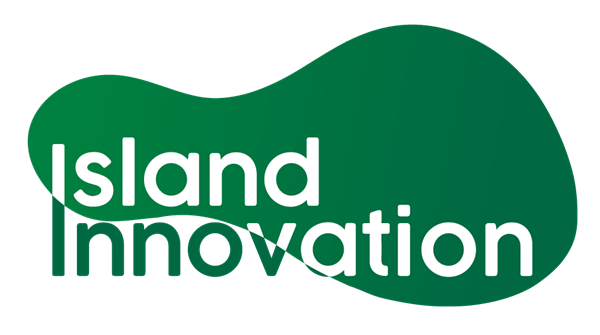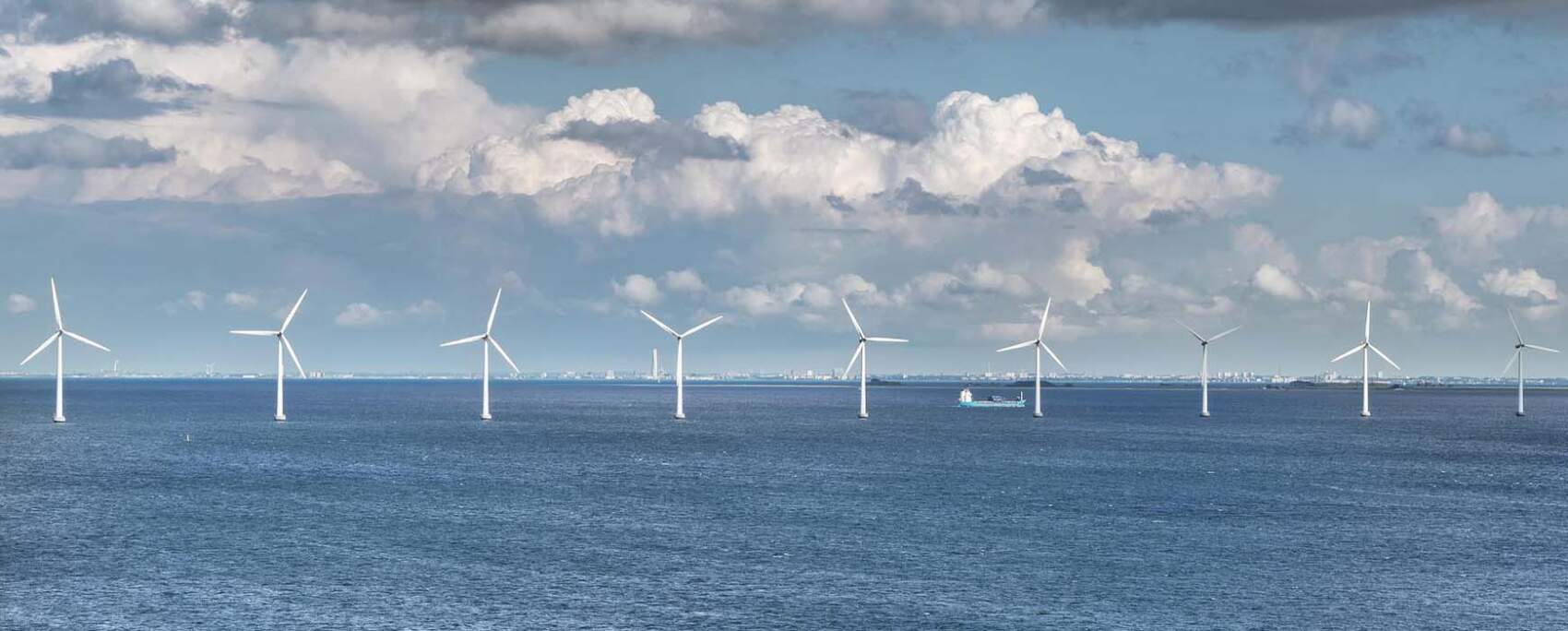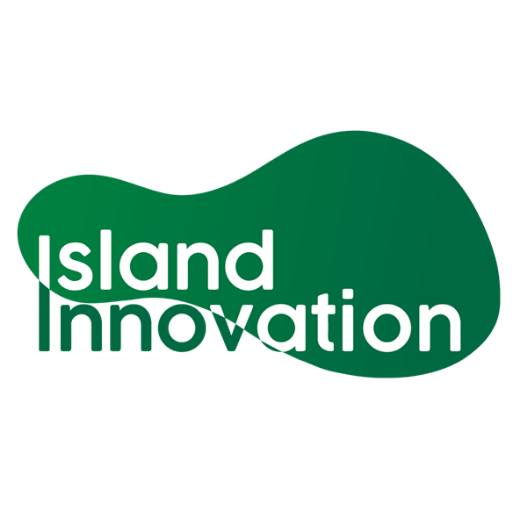Introduction
The ocean is one of the most powerful forces on the planet. More than 70% of the planet’s surface is covered by it and Islands are in a prime position to utilize its energy, cultivating a “Blue Economy”. The “Blue Economy” seeks to address the need to foster economic development while promoting ocean health and human well-being, and one of the key aspects of building resilient island communities is to utilize this immense trove of renewable ocean energy.
For many small islands—including many Small Island Developing States (SIDS)—ocean energy presents a viable option for switching to renewable energy. A lot of small islands don’t have enough landmass to support large wind or solar installations, but they are surrounded by ocean that could provide blue power all day, all year round.
Renewable Ocean Energy Types
There are four main types of ocean energy: Tidal Energy, Current Energy, Wave Energy, and Ocean Thermal Energy. All of these could benefit islands and help them gain more consistent, cleaner, and more independent energy.
Tidal Energy
Tidal power was developed in the 20th century with the first commercial power plant located in La Rance, France. Tidal power plants, Like Hydroelectric dams, hold back huge amounts of water brought in by the tides and generate power using turbines when this water is released. There are three main types of tidal energy: Tidal steam, barrages and tidal lagoons.
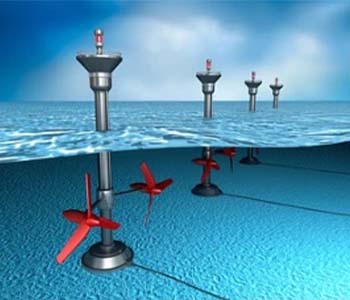
Image: shutterstock
Tidal streams are the currents created by the tides going in and out. Harnessing this energy is relatively straightforward, and is just a matter of placing turbines, much like wind turbines, in the path of the tidal streams.

Image source: https://www.britannica.com/science/tidal-power
A barrage, or tidal dam, works very similarly to any river dam. The dam is built across a river estuary, the water from high tide fills a tidal basin and is then released during low tide, allowing it to spin turbines as the water flows. Some drawbacks to this strategy are that there is a lot of construction involved, and much like how river dams change the topography and water flows, so does the barrage, which can be harmful to the surrounding ecosystems. The barrage is a very powerful energy source which makes the turbines spin very fast and can cause changes in the salinity of the water, further affecting the environment.
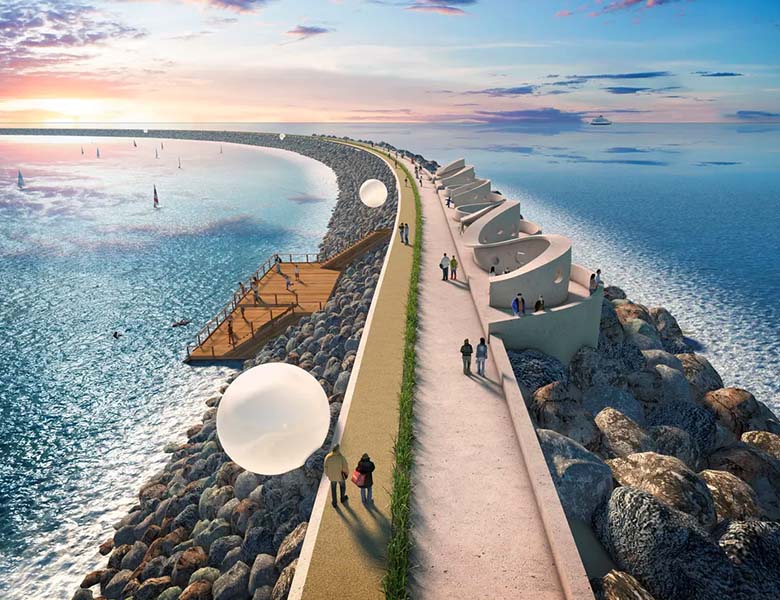
Image: Tidal Lagoon Power/PA http://www.tidallagoonpower.com/
Tidal lagoons function similarly to a barrage but work as a lagoon is being filled and emptied. Unlike barrages which span the entire river estuary in a straight line, tidal lagoons are built to enclose natural coastlines with high tidal ranges. The footprint of these structures is carefully designed for the local environment.
In general, the positives for tidal energy are that, unlike wind energy, tides are predictable, creating a more reliable energy source. Tidal energy is also closer to the coast than some other ocean energy sources, making it easier and potentially cheaper to implement and maintain. However, this does come with some negatives. Tidal turbines have the potential to shift tides and change the ocean environments, harming local ecosystems and wildlife.
Tidal energy is most realistic for places with a large tidal range, meaning the difference in height between high and low tides. Places that have good potential for this tidal range are China, France, England, Canada, and Russia, and island nations such as New Zealand and Indonesia.
Current Energy

Image source: https://ocean.economist.com/innovation/articles/milestone-moment-for-ocean-current-energy
Ocean current energy is comparable to wind energy. By placing large underwater turbines into the paths of ocean currents we are able to generate energy. The turbines that are used tend to be similar to ones used to collect tidal energy. Like tidal energy, current energy is consistent making it of great interest for island communities looking to power their facilities. On top of this, greater current flow velocities can be found in the underwater topography between islands and the mainland resulting in high energy production potential that island communities can take advantage of.
Unlike tidal turbines, Current turbines are designed for low flow rates and don’t need to be designed for reverse flow, meaning that they can be less complicated, which can save money on the engineering and production of the turbines. Currents tend to be further offshore, in deeper parts of ocean, therefore fixed substructures are impractical and expensive. To overcome this, turbines are usually suspended from moored surface platforms or connected to buoyant structures tethered to the ocean floor.
Major concerns with this technology include the price. Implementation of any new energy technology will have high up-front costs but will be worth it in the long run. Another concern is that by placing these turbines in the currents animals that use them can run into them and the flow can be altered, having potentially harmful effects on the surrounding ecosystems.
Wave energy
Wave energy is where the force of waves can be used to drive mechanical systems to generate energy. There are several different ways wave energy can be collected. Originally most wave energy collection was located just off the coastline; however, now increasingly large experimental plants are moving to the open sea.
The first patent in wave energy was issued in Paris in 1799. Monsieur Girard and his son proposed using direct mechanical action to drive heavy machinery, including mills, saws, and pumps.
Since then, five main types of technology have been created, including; Absorbers, Attenuators, Oscillation water columns, overtopping and Inverted- Pendulum device.
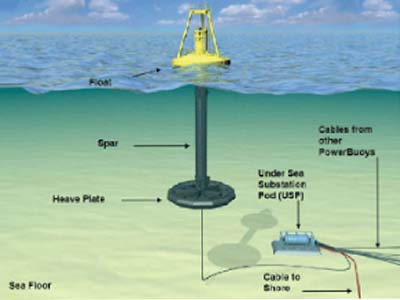
Image source: https://www.energy.gov/eere/water/marine-and-hydrokinetic-technology-glossary
Absorbers use buoys to extract energy from the rise and fall of the waves. The energy is then converted to electrical energy with a linear or rotary generator.
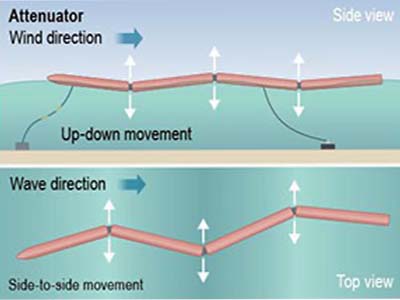
Image source: https://www.researchgate.net/figure/Working-principle-of-point-absorber-11_fig1_271949918
Attenuators capture energy by being placed perpendicular to the length of the wave, this causes the structure to contentiously flex where segments are connected. This system is then connected to hydraulic pumps which convert the energy.
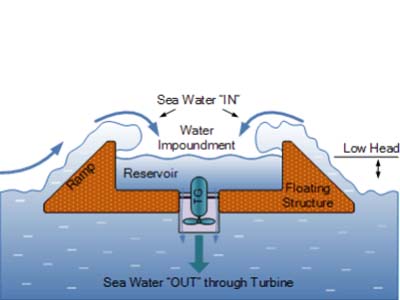
Image source: https://www.alternative-energy-tutorials.com/wave-energy/wave-energy-devices.html
Overtopping has a wave lift over a barrier which fills a reservoir with the water and is then drained through a hydro turbine. This technology is very similar to a conventional hydropower dam.
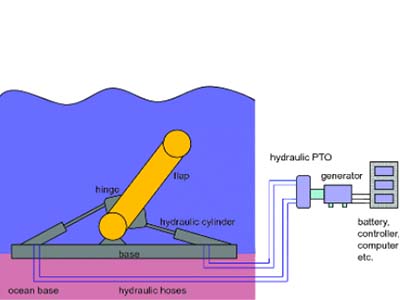
Image source: https://www.researchgate.net/figure/A-concept-design-of-an-Inverted-Pendulum-wave-energy-converter-WEC-in-the-bottom-wave_fig1_317309466
Inverted-Pendulum device uses the motion of waves to move a hinged paddle back and forth. The motion of the paddle drives hydraulic pumps which drive electrical generators.
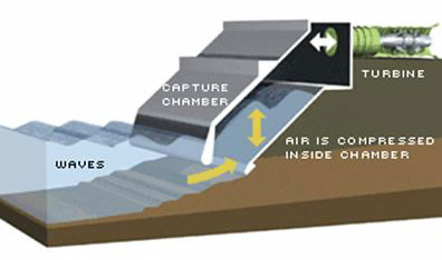
Image source: https://www.researchgate.net/figure/Working-principle-of-OWC-33_fig4_271949918
Oscillation Water Columns (OWC) is a partially submerged enclosed structure. The upper part of the structure, above the water, is filled with air and incoming waves are funneled into the bottom part of the structure. The waves cause the water column to rise and fall which causes the air in the top of the structure to pressurize and depressurize. This in turn pushes and pulls air through a connected air turbine at the top of the structure, converting the energy.
Wave energy is estimated to be the largest global resource form of ocean energy. This would benefit island communities as they have a relatively high percentage of coastline so they would be able to take advantage of this resource. However, since wave energy is still relatively new, there are fewer areas that currently have or are installing wave farms. Some main areas for wave farms are Portugal, the United Kingdom, Australia, and the United States. Because this technology is in the early stages of development, the cost of wave power is still fairly high compared to other forms of technology.
Ocean thermal energy
Oceans thermal energy or OTEC utilizes the huge heat reservoirs contained within the ocean. The temperature differential between warm surface waters and cold deeper layers in intertropical regions can be used to generate steam and then power.
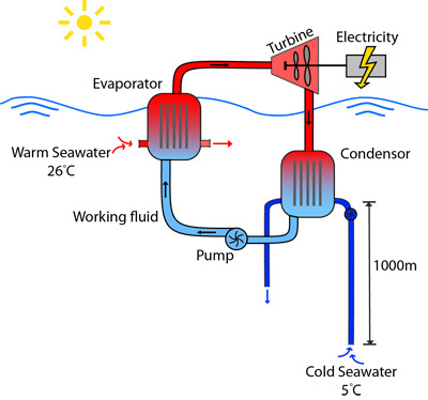
Image source: https://takvera.blogspot.com/2015/07/harnessing-ocean-temperature.html
A working fluid is a fluid that does a job like spinning turbines or cooling your refrigerators. This working fluid boils and evaporates, or vaporizes at low temperatures. The warm ocean water that has been heated by the sun is pumped into the evaporator causing the working fluid to vaporize. Steam from the working fluid is then used to spin the turbine to create electricity. The vaporized working fluid is now sent deeper into the ocean where cold deep ocean water is pumped through a condenser causing the vaporized working fluid to turn back into a liquid and the cycle is repeated. Some iterations of this process can actually produce desalinated drinking water through evaporation and condensation. This could be of great benefit to island communities.
Island communities such as Hawaii and Japan are on the forefront of research for this technology. In 1974 the US established the Natural Energy Laboratory of Hawaii Authority. This lab is one of the world’s leading OTEC test facilities. The pros are that this process can create desalinated water for drinking and agriculture. The process is also fuel free and provides consistent energy for coastal and island communities. Additionally, the environmental impacts are relatively low. However, although the environmental impacts seem relatively low, we are not totally sure about the environmental effects this system could have. Deep water is generally more nutrient dense and has less oxygen. Pumping this cooler nutrient dense water could disrupt the ecological balance. This technology is also expensive and would only work in a few parts of the world where the temperature differentials of the ocean water are large enough.
The Island Pavilion at the UN Ocean Conference
The Island Innovation team will be on the ground at the 2022 UN Ocean Conference, providing live coverage and synopsis to connect islands around the world to what’s happening in Lisbon.
Harnessing the power of the ocean to generate renewable, clean energy will be a key part of the Conference discussions. The UN has set 10 ocean-related targets to be achieved over this decade, as part of the 2030 Agenda for Sustainable Development, the Organisation’s blueprint for a fairer future for people and the planet. They include increasing scientific knowledge and advancing marine technology, fostering the Blue Economy, preventing and reducing pollution and acidification, protecting ecosystems, and regulating fisheries.
The UN Ocean Conference is an international event that has the potential to turn the tide on ocean conservation. Register now to receive the most relevant information, updates, and news from our team on the ground. The registration is 100% FREE and grants you access to all the resources available in this hybrid event.
Conclusion
The ocean is an excellent source for clean, renewable energies. Because the ocean is so accessible to island communities in particular, any one, or some combination of these energies can help these communities build sustainable Blue Economies.
